The fortnight between Ganesh-Visarjan and the first day of Navratri is observed by Hindu families as Pitrupaksha or the days of Shraddh, when post-death rituals are performed. Families remember and pray for their ancestors, gratifying their spirits by often preparing feasts to offer them always including those dishes much-loved by the immediate ancestors they are being offered to – great grandparents, grandparents, sometimes, parents. In return, ancestors are believed to protect and bless their young descendants with joy and prosperity, fulfilment and good health.
This fortnight often falls in October and is marked by intense heat often locally called Shraddh no taap or Otrachitra. Till a few years back, the monsoon receded in India by end of September, causing very warm and humid climate in October and mild nip in the air towards evenfall as we moved towards the coming winter season. People opened up their homes, especially the cupboards and the attics, and aired mattresses and the packed-away razaais, silk sarees, woolens and shawls in the heat beating down on the terraces to rid them of all mustiness. Not anymore. Climate change has taken the monsoon well into October and more in most states.
I feel that like our ancestors, our heritage too, tangible or intangible, waits for us to remember it, honour it, respect it sometime during our busy lives. Like the immediate material benefit we sometimes accrue on the passing of a parent or a near family member, the destruction of a heritage building will certainly pay the destroyer in immediate terms, and no more. But if it is remembered and valued, it will be a gift that continues to give year after year after year.
Just look at Champaner-Pavagadh. The UNESCO World Heritage Site status has slowly and steadily increased footfalls at the Champaner village monuments, increasing visitor fees for ASI many times over than it did when earlier it did not catch anyone’s attention and everyone just went up the Pavagadh hill either to the temple at the top, or as trekkers exploring different routes, as art students to practice sketching and photography, or simple fun-loving picnickers. Now the Champaner monuments have become popular with tourists from within the country and foreigners, with Pre-Wedding photographers, advertising agencies that shoot commercials to promote sarees, and traditional and contemporary fashion clothing, and Gujarati and Bollywood movies shooting song and dance sequences, earning lakhs for the ASI every year.
And the number of luxury and budget hotels that have sprung in the villages in and around Champaner-Pavagadh over the last two decades have to be seen to be believed! When we were working on the site before it got the recognition, we travelled on a single lane, bumpy road that took a good two hours to reach Pavagadh. The afternoon lunch would be a simple, freshly made and wholesome Gujarati thali at the Toran hotel at the Machi plateau. If we needed to stay overnight, there were the modest rooms at Toran itself.
Darbargadh Jambughoda. Pic by Vinay Panjwani, courtesy Smt. Bhavna Rana, Jambughoda
Then post the UNESCO recognition, the lovely homestay at the Jambughoda Darbargadh blossomed into a full-fledged heritage hotel when in 2010, Cox and Kings tied up with the Indian Railways for the prestigious Maharaja’s Express train’s Princely India tour of 8 days and 7 nights, that took tourists from Mumbai to Baroda (included post-breakfast visit to Champaner Pavagadh in the morning and onwards to Jambughoda for a Royal Lunch in silver thalis and return to the Fatehsinh Museum to see the Ravi Varma paintings and the Laxmi Vilas Palace for high tea), and then onwards to Udaipur, Jaipur and Jodhpur and so on to New Delhi. Since then, the Jambughoda Darbargadh has gone from strength to strength, having converted the old stables into luxurious rooms, added a pool and last year, initiated critical conservation inputs in the double-storeyed Darbargadh and the large wooden flooring hall on the third floor that can hold mini conferences, mehfils, get-togethers.
The Champaner Heritage Resort at Bhamaria village, the main Darbargadh. Courtesy Smt. Vidyutshikha Sarvaiya
Just a few years back, the Sarvaiya family from Baroda, bought an old heritage property in village Bhamaria-Sonipur, close to Champaner and restored the crumbling Darbargadh there very well indeed, surrounded by mango groves and spacious manicured gardens, lakes and woods. These otherwise threatened heritage properties have thus piggybacked on the recognition received by Champaner-Pavagadh, their owners have found financial sense in restoring them, welcomed visitors round-the-year on their premises, encouraging people to take delight in not just Champaner Pavagadh but in other natural beauty spots nearby such as the Dev Dam, Hathni Mata waterfalls, Ratanmahal Bear Sanctuary (70 kms away), and the Statue of Unity (90 km).
Sunrise over the pool and dining room at Kadwal County.
A little distance away but closer to the Rathwa-adivasi region is the small former principality of Kadwal. The large Darbargadh Kadwal has been divided between two brothers and post the announcement of UNESCO recognition to Champaner-Pavagadh, both parts of the Darbargadh readied the heritage structure to adapt as comfortable and well-appointed homestays. Kadwal County is the smaller of the two, with 6 double rooms plus a wonderful tree-house and a small swimming pool that opens onto corn fields. Kadwal County is almost always booked for all weekends, extended holidays and vacation times. Superb cooking supervised by the lady of the house is an added plus plus!
In addition to the boost given to the heritage structures, the thick forests that encircle the Pavagadh hill and that flank the roads taking one to Jambughoda or Bhamaria or Kadwal, allow for camping, trekking and other adventure activities. This has promoted several hospitality entrepreneurs to create safe and hygienic camping facilities, a true boon for children from schools in nearby towns and cities for day and weekend trips.
All the investment in the hospitality and entertainment industry and its complementary requirements has created significant local employment, encouraging local entrepreneurs in a major way. The government, I believe, has recently sanctioned 180 crores for development of Champaner-Pavagadh. I only hope they keep the local ASI in the loop so that the sensitive aspects of heritage conservation remain the highest priority.
Baroda town, as the former Gaekwad capital, has some of the best examples of Indo-Saracenic Architecture. But we haven’t really bothered to look after many of them. The future of the vast and massive Nyay Mandir and the Lal Court nearby is still uncertain. We have as good as destroyed the remnants of the Wall from which the Walled City gets its name. We have lost the historically important Nazarbaug Palace and the Shantadevi Hospital, while the Sarkar Wada, Jamnabai Hospital and the Bhadra Kacheri are in need of immediate attention. The condition of smaller monuments such as the beautiful Chhatris, Tulsi Vrundavans and small temples built in commemorative memory of men and women from royal Maratha families that we see dotted along the Vishwamitri river banks are often in a dilapidated condition. And, God forbid, if the Vishwamitri riverbank project does come along, these will be demolished and trashed to make way for cemented walkways.
I always laugh when our small town vernacular media and petty, money-minded politicians raise a hue and cry and flail about dramatically about why our fantastic ‘sanskarnagari’ which has so many heritage monuments cannot become World Heritage City, and Ahmedabad can. Of course, it cannot, you *&^%$# when all you are doing is systematically knocking off heritage monuments and buildings after deliberately allowing them to rot and decompose and then declaring them structurally dangerous! The Corporation has not even bothered to empanel and structure a proper Heritage Cell with qualified persons (not just one person!) to advise and monitor the Corporation on the heritage treasures in the city. This after the Gujarat High Court has summarily directed them to do so after INTACH (Vadodara chapter) filed a PIL when the Nazarbaug Palace was demolished so many years back!
The Pushpakoot Bungalow. Pic courtesy Indian Express
And now, rather a few days back, the Polo Club area woke up to the systematic bang and clank of labourers knocking off the doors and windows of the 122-year old, Pushpakoot, where former Indian Test captain Vijay Hazare and his family lived for 37 years, and whose ownership passed on to the Government in the mid-1970s after which the Office of the Charity Commissioner operated from those premises. Over the last few years, this office has moved somewhere near the Central Jail and the Pushpakoot building was left unoccupied and unattended, till there was an order to demolish it. Apparently four similar double-storeyed, brick bungalows were built by Baroda State, diagonally opposite the Bagikhana which earlier housed stables for the royal horses and carriages, later replaced by garages for the amazing cars in the Gaekwad collection. Two bungalows, in line with Pushpakoot continue to be occupied by families from the large and extended Gaekwad parivar. One (Amrakoot) appears to have been demolished some decades back when it was also sold off. When some persons from the Heritage Trust reached the site, in a casual conversation with the labourers having a tea break, the labourers happened to mention what a strong building it is …
So here’s the thing then – when we talk of a sustainable world, why are we bringing down strong buildings with heritage and historical value (this one can be easily designed for re-adaptive use, such as a Museum of Cricket in Baroda with special rooms dedicated to cricketing greats from the city), and creating ugly structures in their place, that turn into garbage heaps within a couple of decades. So much space is taken in landfills to dump building waste and so much energy and natural resources are spent in creating new buildings!
Heritage of all kinds has so much to offer, if only we could stop and listen and not look at short-term profits only!
Another view of Pushpakoot. Look at the land around, right in the middle of town. Pic Indian Express

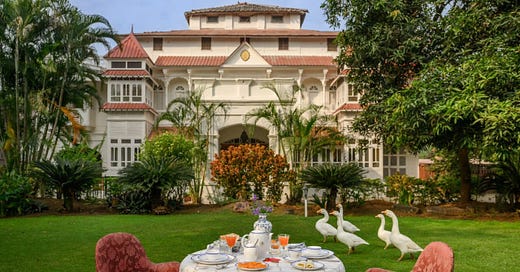



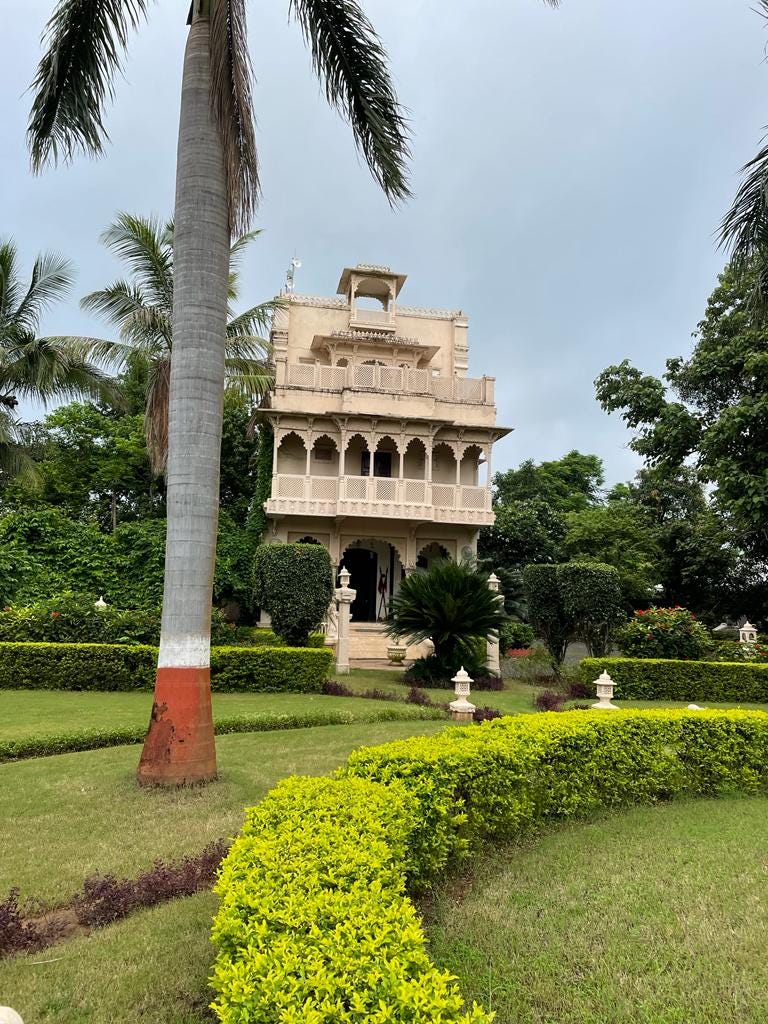
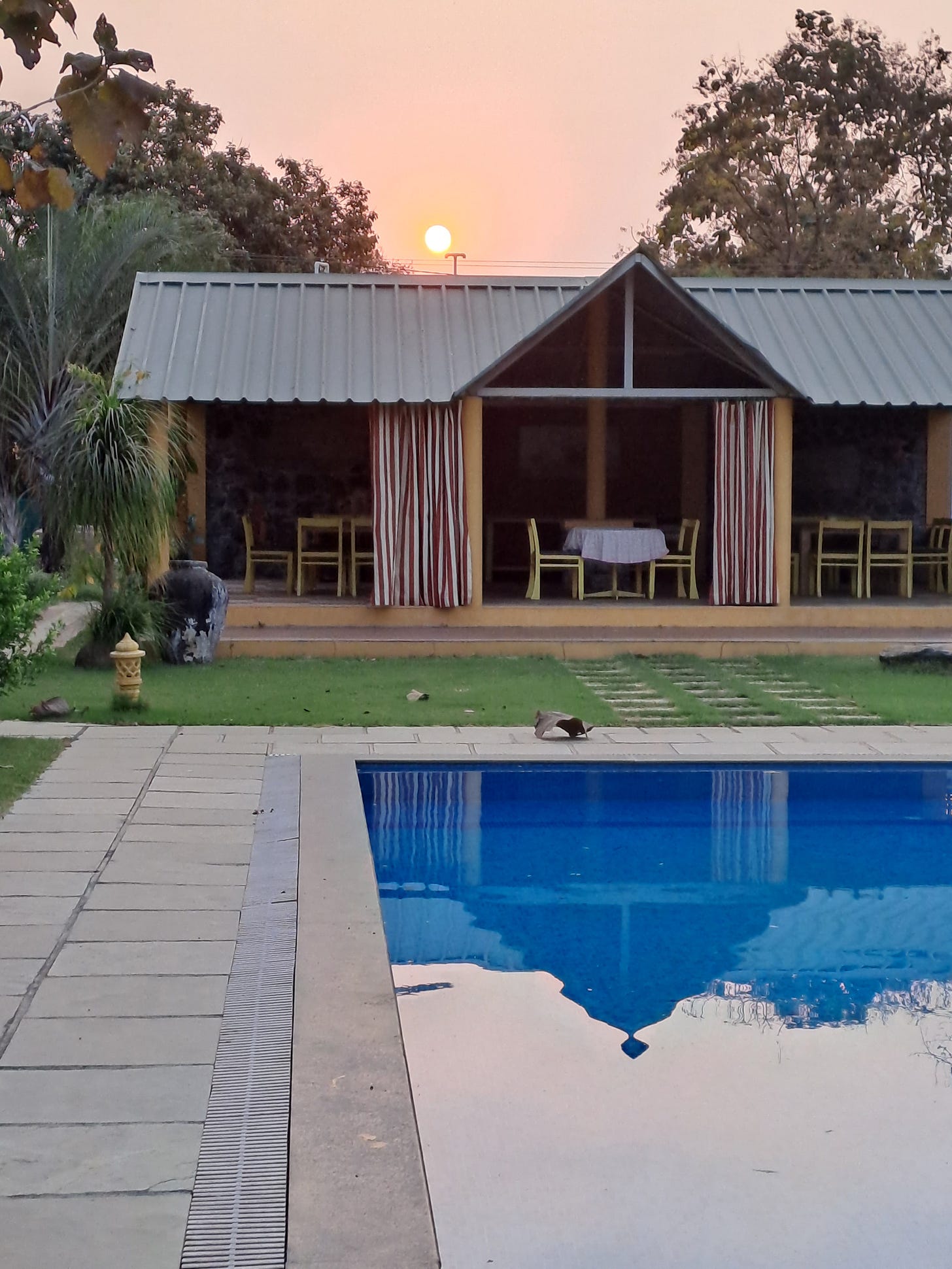
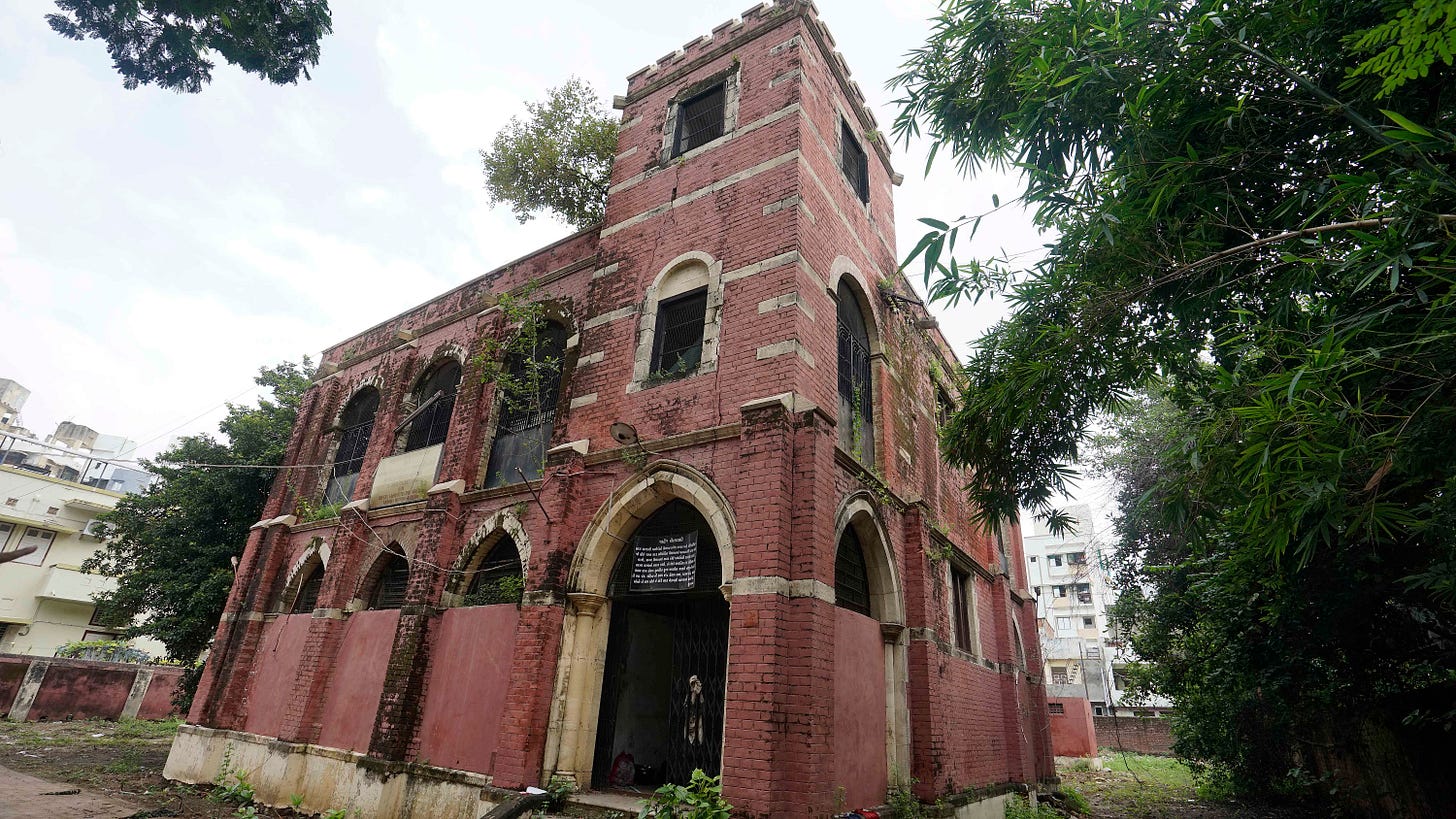
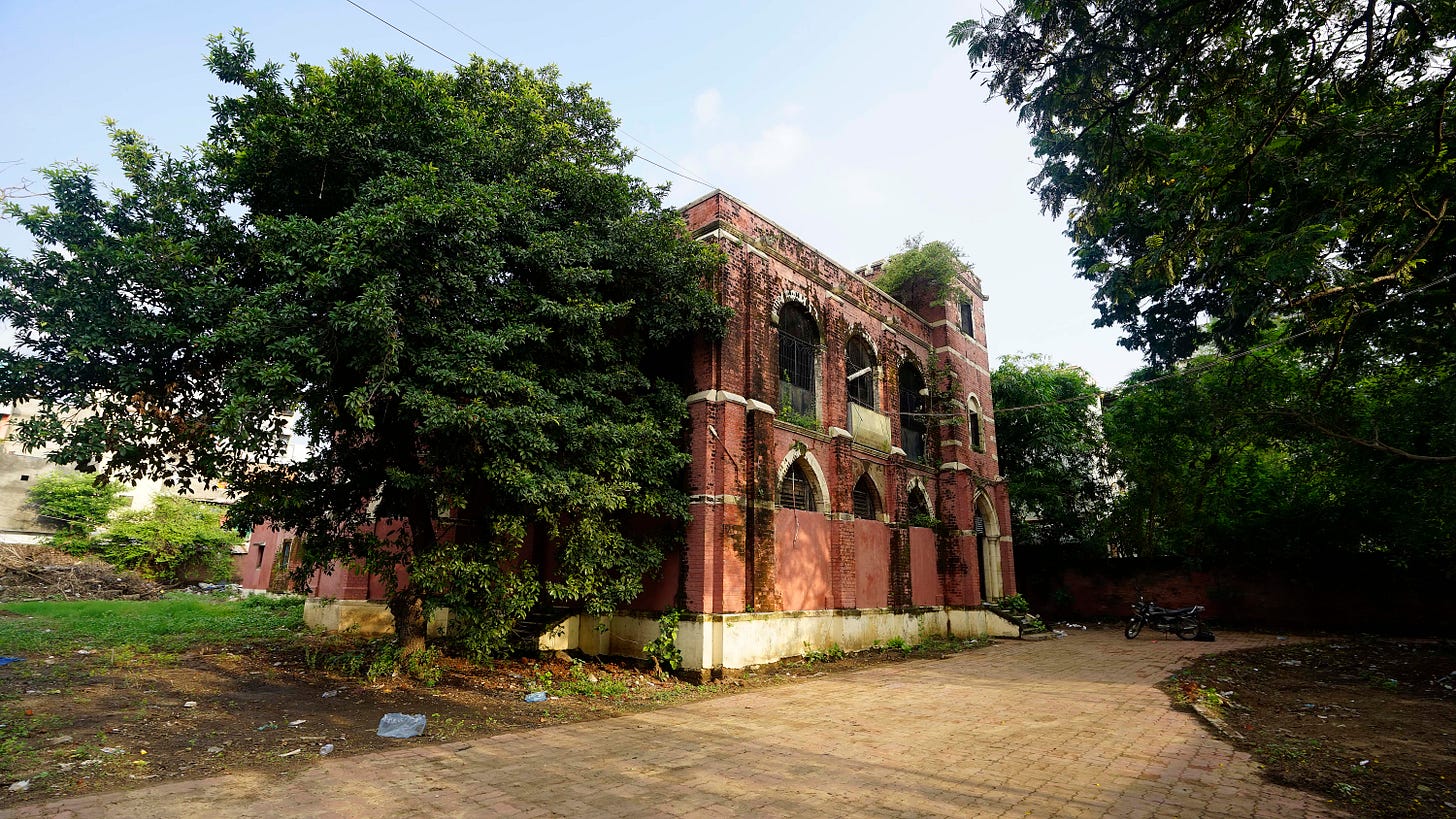
UNESCO is a toothless tiger, Kalpana. For a number of years now, they have no funds and are dependent on host governments to foot the expenses for their travel and accommodation to heritage sites that are usually in remote areas. So obviously they can never exert any pressure of any kind. Sometimes I feel we should not have bothered about Champaner at all and focussed attention on it -- it might have been in a better condition.
Great analogy of remembering our ancestors time period memorabilia these amazing monuments and making active effort in trying to keep them functional for future generations